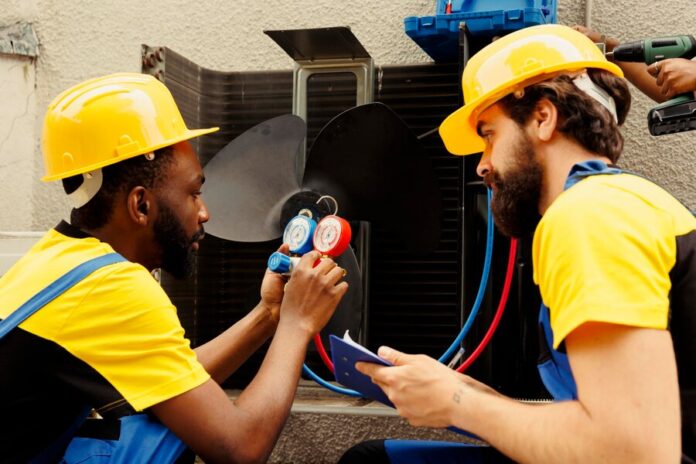Heating, Ventilation, and Air Conditioning (HVAC) projects are intricate endeavors that demand precision, expertise, and the right tools for successful execution.
From installing new systems to maintaining existing ones, HVAC professionals rely on a range of instruments to ensure efficiency and effectiveness.
In this article, we delve into the essential instruments that form the backbone of smooth HVAC project operations, exploring their functionalities and the critical role they play in maintaining indoor comfort.
1. Thermometers
Temperature regulation lies at the heart of HVAC systems, making thermometers indispensable tools for HVAC professionals.
Accurate temperature measurements guide technicians in diagnosing issues, calibrating systems, and ensuring optimal performance.
From infrared thermometers for quick surface readings to digital thermocouples for more precise measurements, having a variety of thermometers is crucial for HVAC projects.
2. Manometers
Balancing air pressure is fundamental in HVAC systems to maintain optimal performance and energy efficiency. Manometers come into play by measuring pressure differentials in ducts and pipes.
Technicians use manometers to identify and rectify imbalances, ensuring that airflow is distributed evenly.
This instrument is particularly vital in projects involving ductwork installation, where achieving the right pressure balance is essential for system effectiveness.
3. Fixings and Fasteners
Fixings and Fasteners secure ductwork, pipes, and components, ensuring structural integrity and system reliability.
From screws and bolts to specialized fastening tools, proper fixation is vital for preventing leaks, optimizing airflow, and guaranteeing the longevity of HVAC installations.
3. Airflow Anemometers
Proper airflow is critical for maintaining indoor air quality and system efficiency. Airflow anemometers measure the speed and volume of air moving through ducts and ventilation systems.
By ensuring that airflow is within the specified range, HVAC professionals can guarantee adequate ventilation, preventing issues like stagnant air, uneven temperature distribution, and system strain. This instrument plays a pivotal role in both installation and maintenance projects.
4. Refrigerant Gauges
In HVAC systems, refrigerants are the lifeblood, facilitating the transfer of heat and maintaining comfortable temperatures.
Refrigerant gauges allow technicians to monitor and control refrigerant levels, ensuring that the system operates at peak efficiency.
With the increasing focus on environmentally friendly refrigerants, these gauges have become even more crucial for compliance with regulations and sustainable HVAC practices.
5. Multimeters
HVAC systems heavily rely on electrical components, making multimeters indispensable for diagnosing issues and troubleshooting electrical systems.
These versatile instruments measure voltage, current, and resistance, helping technicians identify faults in circuits, control panels, and electrical connections.
A comprehensive understanding of the electrical aspects of HVAC systems is essential for project success, and multimeters are the go-to tools for achieving this.
6. Leak Detectors
Refrigerant leaks pose a dual threat to HVAC systems—environmental harm and decreased efficiency. Leak detectors are vital instruments for identifying and locating refrigerant leaks promptly.
Whether using ultrasonic, electronic, or heated diode detectors, HVAC professionals can mitigate the environmental impact and prevent system damage by addressing leaks in a timely manner.
Incorporating leak detection into HVAC projects is a proactive measure that aligns with sustainability goals and ensures long-term system performance.
7. Combustion Analyzers
In HVAC projects involving furnaces and boilers, combustion analyzers play a pivotal role in optimizing combustion efficiency.
These instruments measure the combustion process parameters, such as oxygen and carbon monoxide levels, enabling technicians to fine-tune the system for maximum efficiency and safety.
With a focus on energy efficiency and environmental impact, combustion analyzers have become indispensable for HVAC projects, particularly in commercial and industrial settings.
8. Pipe and 
Insulation is a key factor in maintaining the efficiency of HVAC systems. In projects involving the installation or maintenance of pipes and ducts, insulation tools are essential for ensuring that thermal energy is retained and not lost to the surrounding environment.
From insulation knives for precise cutting to insulation hangers for secure attachment, these tools contribute to energy efficiency, reduce heat loss, and improve the overall performance of HVAC systems.
9. HVAC System Analyzers
For a comprehensive evaluation of HVAC system performance, HVAC system analyzers come into play. These advanced instruments assess multiple parameters, including temperature, pressure, and airflow, providing a holistic view of the system’s functionality.
Technicians use system analyzers during commissioning, retro-commissioning, and regular maintenance to identify inefficiencies, optimize settings, and ensure that the HVAC system operates at peak performance levels.
10. Digital Gauges and Smart Technology
As technology continues to advance, digital gauges and smart tools are revolutionizing HVAC operations. Digital gauges offer real-time data, making it easier for technicians to monitor and adjust system parameters on the fly.
Smart technology, such as connected thermostats and building automation systems, allows for remote monitoring and control, enhancing efficiency and responsiveness in HVAC projects.
Integrating these modern instruments into HVAC operations not only improves performance but also aligns with the industry’s ongoing efforts toward sustainability and energy conservation.
Conclusion
In the dynamic field of HVAC, success hinges on the precise orchestration of various instruments. From traditional thermometers to cutting-edge smart technology, each tool plays a crucial role in ensuring the smooth execution of HVAC projects.
As the industry continues to evolve, staying abreast of the latest advancements in HVAC instruments is essential for professionals seeking excellence in system installation, maintenance, and optimization.


